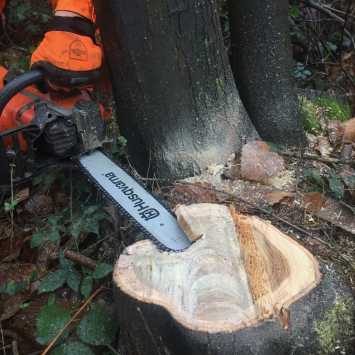This seventh article in the series looks at the Danish felling cut in more detail, including its wide range of application. Remember, this written article is no substitute for the personal delivery of tree felling skills and should be seen as a support to that primary personal delivery.
As previously discussed, this cut is versatile - it’s ideally suited to trees with a modest backward lean or with a biased canopy where the use of a standard felling cut would more than likely result in the kerf closing and trapping the chain saw guide bar. It can also be used if you’re unsure whether the tree is upright or backward leaning, where canopy interaction might resist felling forces and can even be deployed on trees with a modest forward lean.
We teach this cut last after the split level and dogtooth because it is limited to trees with a diameter of around three times guide bar width for backward leans. This is so the split level is better because there are no limits to its use on smaller trees. The dog tooth is safer for heavy forward lean, having said that it does offer a significant benefit in terms of operator positioning around obstructions, such as chestnut coppice stools where many other even-sized stems can limit the scope to work from either side. So for a slight backward lean in a coppice stool setting, this cut is ideal.
Over-reliance on the Danish can mask a lack of understanding of the alternatives; this has more severe implications moving from the assessment world where commercial variations in tree size would be better matched by a thorough knowledge of double V, dogtooth and split level.
The link between dog-tooth and Danish in the common use of a bore cut slots neatly into the logical sequence presented on our training courses and can offer a handy solution when cuts are muddled. We see this where a split level is intended, but a through tree bore is competed - turn the unwanted dog-tooth to a Danish.
The use of a Danish cut should be subject to detailed tree, species and site assessment beyond the scope of this article or any written description of a practical skill.
As on all felling, prepare the tree and immediate area for felling via brashing, removing or cutting material in the way and thinking about the intended route of the tree. Then remove any smaller material likely to deflect or cause low-level hang-ups.
A felling lever is required for this cut, so have this available in a handy spot where you’re not going to trip over or have to cross a danger area to get hold of it. Choose a lever suited to the likely felling force, but beware of miss-matched chainsaw pitch and felling lever thickness – it should be a neat fit. Applied felling force is a function of the following factors that will have a more detailed look at a future article on assisted felling techniques.
- Operator applied force
- Lever length
- Hinge position
- Tree diameter and distance from lever fulcrum
- Tree bearing capacity – compression and splitting
- De-buttress the tree if there are no signs of decay or clean the sides if improved visual clarity is required.
- The directional sink is formed with two cuts that meet; it has an open or angled face around 55-60 degrees and a flat base; ideally, the sink extends to 20-25% of the tree diameter. It is formed at 90 degrees to the felling direction. Don’t overcut, and remember to use the saws felling sights for directional accuracy.
- Deploy accuracy aids as required, such as straight sticks or mark the clean-cut side surface with hinge dimensions.
- Bore through the tree to create a hinge of the usual dimensions (around 10%) and pull the saw out of this bore at the approximate centre of the tree. Keep the saw under close control, particularly when accelerating the chain if you’ve paused to check progress.
- Continue from this position to exit the rear section of the tree under control, place the safe safely to the side and insert the appropriate felling lever into the kerf. This leaves a segment of the tree uncut, which may be in compression, neutral or tension.
- From any convenient position, make a cut to overlap the segment at around 25mm below; the overlapping cut allows the fibres to break laterally like a step cut and the tree to fall, usually with the assistance of a felling lever.


